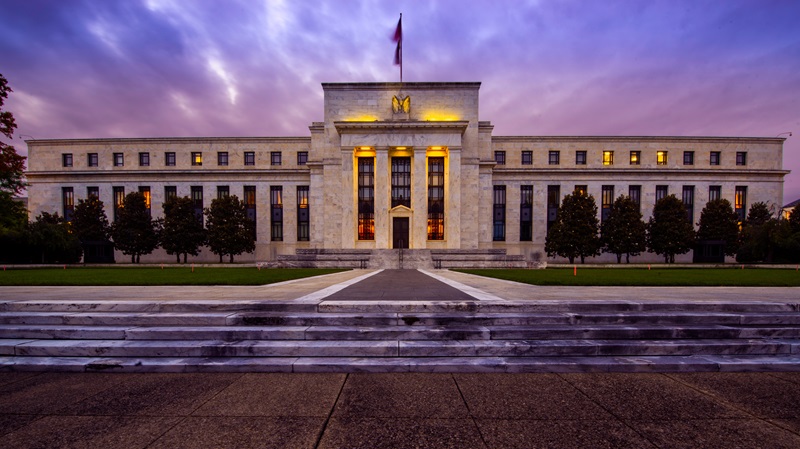The Federal Reserve Open Market Committee (FOMC) has wrapped up its July meeting Wednesday afternoon, and decided for the fifth consecutive meeting, to hold the federal funds rate steady at 4.25%-4.50%.
“Although swings in net exports continue to affect the data, recent indicators suggest that growth of economic activity moderated in the first half of the year. The unemployment rate remains low, and labor market conditions remain solid. Inflation remains somewhat elevated,” said the Fed in a statement to the press. “The Committee seeks to achieve maximum employment and inflation at the rate of 2% over the longer run. Uncertainty about the economic outlook remains elevated. The Committee is attentive to the risks to both sides of its dual mandate.”
The Fed’s decision comes amid increased pressure from President Trump and members of his administration to drop rates, amid accusations of overspending on renovations to the Federal Reserve headquarters in D.C.
News from the Fed comes just hours after Commerce Department data revealed the U.S. economy growing this spring, with the nation’s gross domestic product (GDP) growing at an annual rate of 3% in April, May, and June, rebounding from three previous months of GDP contraction.
“This was a strong reading for economic activity in the second quarter, showing a growth rate of 3.0%, which followed a contraction of 0.5 percent in the first quarter. Due to the impact of tariffs and future tariff implementation, we continue to see large swings in import and export activity, which impact the topline growth number,” said Mortgage Bankers Association (MBA) VP and Deputy Chief Economist Joel Kan. “Personal consumption expenditures picked up slightly and provided a percentage point boost to overall growth after slowing briefly in the first quarter. The growth in consumer spending on goods and services, while positive thus far in 2025, has been at a slower pace than in 2024.”
President Trump took to Truth Social early Wednesday to urge the Fed to cut rates.
“2Q GDP JUST OUT: 3%, WAY BETTER THAN EXPECTED! “Too Late” MUST NOW LOWER THE RATE. No Inflation! Let people buy, and refinance, their homes!” said President Trump in his post.
Voting for the hold in policy action were Powell, Fed Vice Chair John C. Williams, and Fed Board Members Michael S. Barr, Susan M. Collins, Lisa D. Cook, Austan D. Goolsbee, Philip N. Jefferson, Alberto G. Musalem, and Jeffrey R. Schmid.
Opposing votes came from Christopher J. Waller and Michelle Bowman, both members of the Board of Governors of the Federal Reserve System, and both of whom publicly called for a rate reduction.
In mid-July, Waller, addressed the Money Marketeers of New York University, to discuss why he feels the Federal Reserve should “reduce its policy rate by 25 basis points” at the next meeting of the Federal Open Market Committee (FOMC).
“Real gross domestic product (GDP) growth was likely around 1% in the first half of this year, and is expected to remain soft for the rest of 2025, much lower than the median of FOMC participants’ estimates of longer-run GDP growth,” said Waller at the Money Marketers meeting. “Meanwhile, the unemployment rate is 4.1%, near the Committee’s longer-run estimate, and headline inflation is close to our target at just slightly above 2% if we put aside tariff effects that I believe will be temporary. Taken together, the data imply the policy rate should be around neutral, which the median of FOMC participants estimates is 3%, and not where we are—1.25 to 1.50 percentage points above 3%.”
Bowman, who serves as Fed Vice Chair, said in a late June press conference in Prague that the Fed could begin cutting rates as soon as July, though she hasn’t reiterated that position since the latest government data showed Americans are still spending and businesses are still hiring.
“Should inflation pressures remain contained, I would support lowering the policy rate as soon as our next meeting in order to bring it closer to its neutral setting and to sustain a healthy labor market,” Bowman said. “In the meantime, I will continue to carefully monitor economic conditions as the Administration’s policies, the economy, and financial markets continue to evolve.”
Marc Halpern, CEO, Foundation Mortgage, said: “While the Fed is predictably keeping interest rates steady, it’s essential to consider that this week is one of the most consequential weeks when it comes to the future of the nation’s economy. All eyes are on several key jobs and consumer confidence reports, which are also being released this week. American households are watching closely and playing it safe by avoiding large purchases, which is why home sales remain sluggish. Once the consumer confidence numbers begin to increase, so will the desire to buy a home.”
Powell has been the target of the Trump administration and members of Congress for the past few months, with Florida Rep. Anna Paulina Luna recently submitting a letter to the U.S. Attorney General’s office seeking a U.S. Department of Justice (DOJ) investigation into accusations of perjury and making false statements to federal officials. Rep. Luna cites Powell’s sworn testimony before the Senate Banking Committee on June 25, 2025, in which he denied the inclusion of luxury features—such as a VIP dining room, premium marble, water features, and a roof terrace garden—in the $2.5 billion renovation of the Federal Reserve’s Eccles Building. According to the New York Post, the projected renovations by the Fed have risen by 30% from its original estimate of $1.9 billion.
President Trump called for the resignation of Powell in early July over the renovation project as well, and U.S. Office of Management and Budget (OMB) Director Vought wrote a letter to Powell over “mismanagement” of the Fed.
“Chairman Jerome Powell has grossly mismanaged the Fed,” said Vought in a social media post accompanying his letter. “While continuing to run a deficit since FY23 (the first time in the Fed’s history), the Fed is way over budget on the renovation of its headquarters. Now up to $2.5 billion, roughly $700 million over its initial cost. These renovations include terrace rooftop gardens, water features, VIP elevators, and premium marble. The cost per square foot is $1,923—double the cost for renovating an ordinary historic federal building. The Palace of Versailles would have cost $3 billion in today’s dollars!”
William J. Pulte, Chair of the Federal Housing Finance Agency (FHFA), and Fannie Mae and Freddie Mac, also called on Congress to open an investigation into Powell over the renovations.
“I am asking Congress to investigate Chairman Jerome Powell, his political bias, and deceptive Senate testimony, which is enough to be removed ‘for cause,’” said Pulte in a social media post on X. “Jerome Powell’s $2.5B Building Renovation Scandal stinks to high heaven, and he lied when asked about the specifics before Congress. This is nothing short of malfeasance and is worthy of ‘for cause.’”
On Wednesday, Pulte took to X to state: “Jerome Powell, again, lies to the American people. This time saying that the Fed has nothing to do with Housing. The Fed has EVERYTHING to do with Housing.”
Bankrate Chief Financial Analyst Greg McBride, CFA, noted, “The ongoing uncertainty about looming tariffs has been like waiting for another economic shoe to drop. But is that other shoe going to be a steel-toed work boot, a beach flip-flop, or something in between? We should get some clarity on that between now and the Fed’s September meeting with updated inflation data, including two CPI releases, and two more monthly employment reports. The tariff timetable is ever-evolving, so uncertainty could continue to prevail into the fall.”
Despite President Trump’s call for resignation, he does not have direct control over the Federal Reserve’s policy decisions, but does have influence. The President can nominate and appoint members of the Federal Reserve Board of Governors, including the Chair, which can influence the overall direction of the Fed, and can also voice their opinions about monetary policy. The President selects one member of the Board of Governors to serve as Chair of the Board, who also serves as the FOMC Chair.
The FOMC, which makes the actual monetary policy decisions, is comprised of all seven governors and five of the 12 regional Federal Reserve Bank Presidents. While the chair has one vote like the other governors, the structure is designed to prevent one individual, including the president, from dictating decisions and policies. Trump appointed Powell as head of the Federal Reserve during his first term in 2018, with his term ending in May 2026.
The Federal Reserve System performs five general functions to promote the effective operation of the U.S. economy:
- To promote maximum employment, stable prices, and moderate long-term interest rates in the U.S. economy;
- Promotes the stability of the financial system and seeks to minimize and contain systemic risks through active monitoring and engagement in the U.S. and abroad;
- Promotes the safety and soundness of individual financial institutions and monitors their impact on the financial system as a whole;
- Fosters payment and settlement system safety and efficiency through services to the banking industry and the U.S. government that facilitate U.S.-dollar transactions and payments; and
- Promotes consumer protection and community development through consumer-focused supervision and examination, research and analysis of emerging consumer issues and trends, community economic development activities, and the administration of consumer laws and regulations.
“The home lending industry remains optimistic of a rate cut this year, but it looks to be some time before the Federal Reserve enacts an interest rate cut decision,” said Matt Pettit, President of Mountain West Financial. “New home starts and sales will continue to dwindle until lending prices come down for mortgage companies. That said, the pressure to see an improvement in home sales is continuing to grow, without the benefit of the Fed lowering interest rates. There may be additional housing policies on the way to try to spur more home sales.”





